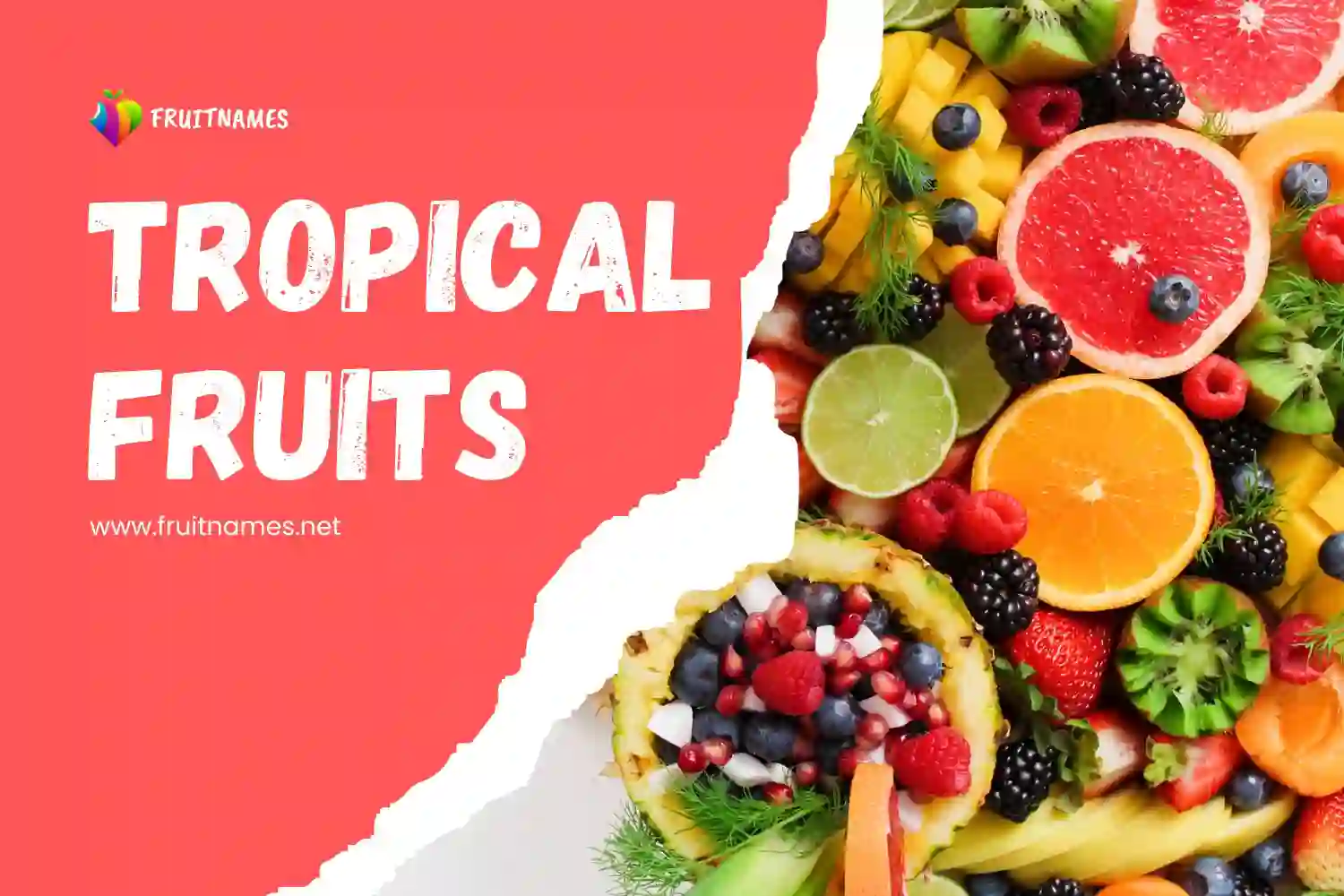In the heart of lush, vibrant landscapes, where the sun-kissed breeze carries the scent of adventure, lies a treasure trove of nature’s most delectable offerings – tropical fruit names. These jewels of the equatorial regions have long captivated our senses with their exotic flavours, vibrant colours, and enticing aromas. As we embark on a virtual journey into the world of tropical fruits, prepare to be transported to paradisiacal orchards where each fruit tells a unique story of its origin, cultural significance, and culinary versatility.
From the velvety sweetness of mangoes to the zesty punch of pineapples, and the creamy allure of avocados, tropical fruits are not just a feast for the palate but a celebration of biodiversity. Join us as we peel back the layers of these succulent wonders, exploring their history, nutritional benefits, and the diverse cultures that have woven them into their culinary tapestry. So, grab a virtual passport and let’s embark on a tantalizing journey through the sun-drenched realms of tropical fruit paradise.
| Serial Number | Picture | English Name | Hindi Name |
| 1 |  | Banana | केला |
| 2 |  | Mango | आम |
| 3 |  | Pineapple | अनानास |
| 4 | 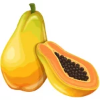 | Papaya | पपीता |
| 5 | 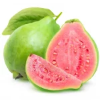 | Guava | अमरूद |
| 6 |  | Coconut | नारियल |
| 7 | 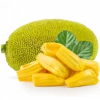 | Jackfruit | कटहल |
| 8 | 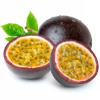 | Passion Fruit | पैशन फल |
| 9 |  | Lychee | लीची |
| 10 | 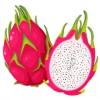 | Dragon Fruit | ड्रैगन फ्रूट |
| 11 | 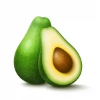 | Avocado | एवोकाडो |
| 12 | 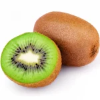 | Kiwi | कीवी |
| 13 | 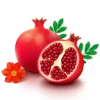 | Pomegranate | अनार |
| 14 |  | Mango (Alphonso) | हापूस |
| 15 |  | Banana (Plantain) | कच्चा केला |
| 16 | 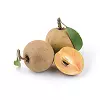 | Sapota (Chikoo) | चिक्कू |
| 17 | 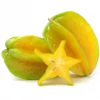 | Star Fruit (Carambola) | कमरख |
| 18 | 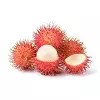 | Rambutan | रैम्बुटन |
| 19 | 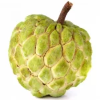 | Custard Apple | शरीफा |
| 20 |  | Coconut (Tender) | ताजगी नारियल |
| 21 | 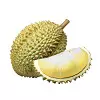 | Durian | ड्यूरियन |
| 22 | 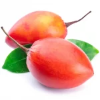 | Tamarillo | टैमरिलो |
| 23 |  | Fig | अंजीर |
| 24 | 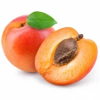 | Apricot | खुबानी |
| 25 |  | Pineapple (Baby) | बेबी अनानास |
| 26 | 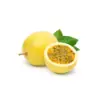 | Passion Fruit (Yellow) | पीला पैशन फ्रूट |
| 27 | 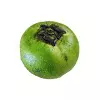 | Black Sapote | काला सपोट |
| 28 | 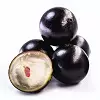 | Jabuticaba | जाबुटिकाबा |
| 29 | 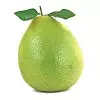 | Pomelo | चकोतरा |
| 30 | 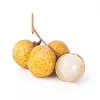 | Longan | लंगन |
Why Are Tropical Fruits Important?
Tropical fruits hold a special place of importance in both cultural and nutritional landscapes, and their significance extends far beyond their delicious flavours. Here are several reasons why tropical fruits are crucial:
1. Biodiversity Hotspots:
Tropical regions are biodiversity hotspots, hosting an immense variety of plant and animal species. Tropical fruits contribute to this rich biodiversity, playing a vital role in the delicate balance of ecosystems. Preserving these fruits is essential for maintaining the health and sustainability of these regions.
2. Cultural Heritage:
Tropical fruits are deeply embedded in the cultural fabric of the regions where they thrive. They often hold symbolic importance in traditional ceremonies, rituals, and celebrations. The cultivation and consumption of these fruits are integral to the identity and heritage of many communities.
3. Nutrient-Rich Powerhouses:
Tropical fruits are nutritional powerhouses, offering a wide array of essential vitamins, minerals, and antioxidants. From vitamin C-rich guavas to potassium-packed bananas, these fruits contribute to overall health and well-being. The unique combination of nutrients found in tropical fruits can provide a natural boost to the immune system and promote vitality.
4. Economic Importance:
Many tropical fruits are significant contributors to the economies of their native regions. Exported globally, they generate income for farmers and contribute to the economic development of tropical countries. The cultivation and trade of these fruits create employment opportunities and support livelihoods.
5. Diverse Culinary Applications:
Tropical fruits are versatile ingredients in the culinary world, adding exotic flavours, textures, and colours to a wide range of dishes. From refreshing fruit salads to savoury salsas, tropical fruits enhance the culinary experience, inspiring chefs and home cooks alike to experiment with vibrant and unique recipes.
6. Climate Resilience:
Some tropical fruit species exhibit remarkable resilience to challenging environmental conditions, including heat and humidity. Understanding and harnessing the resilience of these fruits can contribute to agricultural sustainability and food security, especially in the face of climate change.
7. Medicinal Properties:
Many tropical fruits have been traditionally used for their medicinal properties. From anti-inflammatory benefits to digestive health support, these fruits offer a natural source of wellness. Ongoing research continues to uncover the potential health benefits of various compounds found in tropical fruits.
Examples of Tropical Fruits
Tropical fruits are a diverse and mouthwatering array of produce, each boasting its unique flavour profile and nutritional benefits. Here are some delicious examples of tropical fruits:
1. Mango (Mangifera indica):
Originating from South Asia, mangoes are known for their sweet, juicy flesh and vibrant orange-yellow skin. They come in various varieties, each with its distinct taste and texture.
2. Pineapple (Ananas comosus):
Native to South America, pineapples are characterized by their spiky exterior and sweet, tangy flavour. They are a refreshing addition to fruit salads, smoothies, and desserts.
3. Banana (Musa spp.):
Bananas are one of the most widely consumed fruits globally. They are rich in potassium and provide a convenient, energy-boosting snack. There are various varieties, including sweet dessert bananas and starchy plantains.
4. Coconut (Cocos nucifera):
The coconut palm offers a bounty of tropical delights. From coconut water to coconut milk, coconut flesh, and coconut oil, this versatile fruit is used in both sweet and savoury dishes.
5. Papaya (Carica papaya):
Native to Central America, papayas are known for their vibrant orange flesh and sweet taste. They are rich in vitamins, particularly vitamin C, and enzymes that aid digestion.
6. Guava (Psidium guajava):
Guavas are tropical fruits with a fragrant aroma and a sweet, slightly tart flavour. They are a great source of vitamin C and dietary fibre. Guavas come in different varieties, including pink and white.
7. Dragon Fruit (Pitaya or Pitahaya):
This exotic fruit has a striking appearance with its bright pink or yellow skin and speckled flesh. Dragon fruit has a mildly sweet taste and is rich in antioxidants.
8. Papaya (Carica papaya):
Native to Central America, papayas are known for their vibrant orange flesh and sweet taste. They are rich in vitamins, particularly vitamin C, and enzymes that aid digestion.
9. Passion Fruit (Passiflora edulis):
This small, round fruit has a tough outer rind and a juicy, seed-filled interior. Passion fruit has a unique, aromatic flavour that is both sweet and tart.
10. Kiwi (Actinidia deliciosa):
Originally from China, the kiwi is known for its fuzzy brown exterior and vibrant green flesh with tiny black seeds. It has a sweet and tangy flavour, and it’s a good source of vitamin C and dietary fibre.
11. Avocado (Persea americana):
Although often associated with savoury dishes, avocados are technically berries and have a rich, creamy texture. They are loaded with healthy monounsaturated fats and are versatile ingredients in both sweet and savoury recipes.
Red Tropical Fruits
Red tropical fruits not only captivate with their vibrant hues but also deliver a burst of sweet and tangy flavours. Here are some enticing examples of red tropical fruits that add a colourful touch to both culinary creations and tropical landscapes:
- Red Dragon Fruit (Red Pitaya): This exotic fruit boasts a vibrant pink or red skin with green scales. The flesh inside can be either red or white, dotted with black seeds. Red dragon fruit has a subtly sweet taste and a refreshing texture.
- Red Guava (Psidium guajava): Guavas come in various colours, and some varieties, like the red-fleshed guava, exhibit a captivating ruby hue. They offer a delightful combination of sweetness and tartness.
- Pomegranate (Punica granatum): While pomegranates are native to the Middle East, they have found their way into tropical regions. The juicy, ruby-red arils inside the tough outer skin are bursting with a sweet and slightly tart flavour.
- Red Banana (Musa acuminata): Red bananas have a distinctive reddish-purple skin and a sweet flavour that is often likened to that of a regular banana but with subtle berry undertones. They are smaller than traditional yellow bananas.
- Roselle (Hibiscus sabdariffa): Also known as hibiscus or sorrel, the calyces of the roselle plant are used to make a vibrant red, tart-flavored infusion. It is commonly used in teas, jams, and culinary preparations.
- Red Passion Fruit (Passiflora edulis): While passion fruit typically has a tough outer rind, some varieties exhibit a red or purple hue. The seeds and pulp inside have a unique, aromatic flavour that blends sweetness with a hint of tartness.
- Acerola Cherry (Malpighia emarginata): Often referred to as the Barbados cherry, acerola cherries are small, red fruits with a tart taste. They are exceptionally rich in vitamin C, making them a popular choice for boosting immunity.
- Red Wax Jambu (Syzygium samarangense): Also known as rose apple, the red wax jambu has a crisp texture and a mildly sweet taste. The fruit is bell-shaped, and its shiny red skin adds to its visual appeal.
- Red Soursop (Annona muricata): A close relative of the green soursop, the red soursop has a spiky exterior and a soft, juicy, red flesh. It has a sweet and tangy flavour, making it a popular choice for juices and desserts.
1. Orange Tropical Fruits
Orange tropical fruits are not only visually vibrant but also pack a punch of citrusy sweetness and nutritional goodness. Here are some delicious examples of orange tropical fruits that bring a burst of sunshine to both your palate and your plate:
- Mango (Mangifera indica): While mangoes come in various colours, many varieties display a vibrant orange hue when ripe. Known for their juicy, sweet flesh, mangoes are a tropical delight enjoyed worldwide.
- Papaya (Carica papaya): Papayas are tropical fruits with orange flesh and a sweet, musky flavor. They are rich in vitamins, particularly vitamin C, and digestive enzymes like papain.
- Oranges (Citrus sinensis): Though commonly associated with temperate climates, oranges are also grown in tropical regions. They are a classic source of vitamin C and provide a refreshing burst of citrus sweetness.
- Tangerine (Citrus reticulata): Tangerines are smaller citrus fruits with a bright orange peel and a sweet, tangy flavor. They are easy to peel, making them a convenient and portable snack.
- Kumquat (Fortunella spp.): Kumquats are small citrus fruits that are typically eaten whole, including the peel. They have a unique sweet-tart flavor and are a good source of fiber and vitamin C.
- Pineapple (Ananas comosus): While the exterior of a pineapple is yellow-brown, the juicy flesh inside is often a vibrant orange color. Pineapples bring a perfect balance of sweetness and tartness to various dishes.
- Papaya (Carica papaya): Native to Central America, papayas are known for their vibrant orange flesh and sweet taste. They are rich in vitamins, particularly vitamin C, and enzymes that aid digestion.
- Persimmon (Diospyros kaki): Depending on the variety, persimmons can range from pale orange to deep red. They have a sweet and honey-like flavor, making them a delightful addition to salads and desserts.
- Apricot (Prunus armeniaca): While apricots are often associated with temperate climates, they are also cultivated in tropical regions. These small, orange fruits have a sweet and slightly tart taste.
- Clementine (Citrus × clementina): Clementines are a type of mandarin orange, known for their easy-to-peel skin and sweet, juicy segments. They are a popular snack during the citrus season.
- Papaya (Carica papaya): Native to Central America, papayas are known for their vibrant orange flesh and sweet taste. They are rich in vitamins, particularly vitamin C, and enzymes that aid digestion.
2. Rare Tropical Fruits
Exploring rare tropical fruits is like embarking on a culinary treasure hunt, unveiling hidden gems that are not only delicious but often carry unique flavors and textures. Here are some rare tropical fruits that might not be as commonly known but are worth seeking out for a culinary adventure:
- Salak (Snake Fruit) – Salacca zalacca: Named for its reddish-brown scaly skin, snake fruit has a sweet and tangy taste. The segmented flesh has a crunchy texture, making it a unique and refreshing snack.
- Rambutan – Nephelium lappaceum: Resembling lychee, rambutan has a hairy exterior that can be red, yellow, or orange. The translucent, juicy flesh has a mildly sweet flavor, making it a delightful tropical treat.
- Jabuticaba – Plinia cauliflora: Unlike most fruits, jabuticaba grows directly on the trunk of the tree. These small, dark purple fruits have a sweet and tart taste, often used to make jellies and wines.
- Cherimoya – Annona cherimola: Also known as the “custard apple,” cherimoya has a creamy, white flesh with a sweet and tropical flavor. It’s often described as a blend of banana, pineapple, and strawberry.
- Durian – Durio spp.: Known as the “king of fruits,” durian is famous for its strong odor, which people either love or find repulsive. Beneath the spiky exterior lies custard-like, creamy flesh with a complex flavor.
- Buddha’s Hand – Citrus medica var. Sarcodactylis: This unique citrus fruit resembles multiple yellow fingers extending from a central base. While it doesn’t have much flesh, its intense lemon fragrance makes it popular for zest and infusions.
- Black Sapote – Diospyros texana: Often referred to as the “chocolate pudding fruit,” black sapote has a green skin and, when ripe, a dark brown, custard-like interior with a taste reminiscent of chocolate.
- Chayote Fruit – Sechium edule: While the chayote squash is more commonly known, the fruit itself is sweet and crisp, with a flavour reminiscent of a combination of pear and cucumber.
- Jujube – Ziziphus jujuba: Jujubes are small, reddish-brown fruits with sweet and chewy flesh. They are often dried and enjoyed as a snack, with a taste similar to dates.
- Yellow Dragon Fruit (Yellow Pitaya) – Hylocereus megalanthus: Similar to the more common red dragon fruit, the yellow variety has bright yellow skin and white or yellow flesh. It has a mildly sweet taste and is rich in antioxidants.
- Mamey Sapote – Pouteria sapota: With a rough brown exterior, mamey sapote has vibrant orange flesh that tastes like a mix of sweet potato, pumpkin, and almond. It’s often used in smoothies and desserts.
3. Tropical Fruits in Florida
Florida’s warm and subtropical climate provides an ideal environment for a diverse array of tropical fruits to thrive. The state is known for its orchards and groves that yield a bounty of delicious and exotic fruits. Here are some tropical fruits commonly found in Florida:
- Oranges (Citrus sinensis): Florida is renowned for its citrus production, particularly oranges. The state’s orange groves contribute significantly to the production of orange juice, making Florida a major player in the citrus industry.
- Grapefruits (Citrus × paradisi): Like oranges, grapefruits flourish in Florida’s climate. The state produces various varieties of grapefruits, known for their sweet and tangy flavor.
- Key Limes (Citrus aurantiifolia): Key limes, smaller and more aromatic than regular limes, are a staple in Florida. They are commonly used in the famous Key Lime Pie, a dessert that originated in the Florida Keys.
- Mangoes (Mangifera indica): Florida boasts a variety of mango cultivars, with the mango season typically running from late spring to early fall. The state is known for varieties like ‘Haden,’ ‘Kent,’ and ‘Tommy Atkins.’
- Avocado (Persea americana): Avocado trees thrive in Florida’s climate, and the state produces both the green-skinned varieties like ‘Florida Haas’ and the smooth, thin-skinned varieties like ‘Choquette.’
- Papayas (Carica papaya): Papaya trees are common in Florida, and the state produces both the red-fleshed and yellow-fleshed varieties. Papayas are enjoyed fresh or in smoothies and tropical fruit salads.
- Bananas (Musa spp.): While bananas are not native to Florida, they are grown in the state, particularly in the southern regions. Various banana cultivars, including ‘Dwarf Cavendish,’ are cultivated.
- Lychees (Litchi chinensis): South Florida, with its subtropical climate, is conducive to growing lychees. The lychee season in Florida typically occurs in late spring and early summer.
- Dragon Fruit (Pitaya) – Hylocereus spp : Dragon fruit cultivation has gained popularity in Florida. The vibrant fruit, with its sweet and mildly tangy flavor, is grown in both red and yellow varieties.
- Star Fruit (Carambola): Star fruit trees thrive in Florida’s warm climate. The fruit, shaped like a star when sliced, has a sweet and slightly tart taste.
- Passion Fruit (Passiflora edulis): Passion fruit vines are cultivated in Florida, providing the aromatic and tangy fruits that are often used in beverages, desserts, and exotic culinary creations.
- Sapodilla (Manilkara zapota): Sapodilla trees, known for their sweet and grainy-textured fruit, are grown in the southern parts of Florida.
4. Tropical Fruits in Hawaii
Hawaii, with its year-round warm climate and rich volcanic soil, is a tropical paradise that supports the growth of a wide variety of exotic fruits. The islands are home to a diverse array of tropical fruits that thrive in the lush landscapes. Here are some of the tropical fruits commonly found in Hawaii:
- Pineapple (Ananas comosus): Hawaii is renowned for its sweet and succulent pineapples. The state’s volcanic soil and tropical climate create optimal conditions for pineapple cultivation, making Hawaiian pineapples sought after for their flavor.
- Bananas (Musa spp.): Bananas of various cultivars, including the apple banana (Manzano) and the common Cavendish, are grown abundantly in Hawaii. The state’s warm and humid climate provides an ideal environment for banana cultivation.
- Papayas (Carica papaya): Hawaii produces both the yellow and red-fleshed varieties of papaya. The fruit is a staple in Hawaiian cuisine and is enjoyed fresh, in smoothies, or as part of tropical fruit salads.
- Mangoes (Mangifera indica): Mango trees thrive in Hawaii, and the islands are home to several varieties, including Hayden, Pirie, and Rapoza. The mango season in Hawaii typically spans from late spring to early fall.
- Guavas (Psidium guajava): Guava trees flourish in Hawaii, and the fruit is enjoyed fresh or used in jams, jellies, and beverages. The state is home to both pink and white-fleshed guava varieties.
- Lychees (Litchi chinensis): Lychee trees are grown in Hawaii, particularly on the Big Island. The sweet and juicy lychee fruits are often enjoyed fresh or in desserts.
- Dragon Fruit (Pitaya) – Hylocereus spp: Dragon fruit cultivation has gained popularity in Hawaii. The fruit, with its vibrant pink or yellow skin and speckled flesh, is known for its mildly sweet flavor.
- Passion Fruit (Lilikoi) – Passiflora edulis: Passion fruit vines are common in Hawaii, and the aromatic lilikoi fruits are used in beverages, desserts, and as a topping for various dishes.
- Breadfruit (Artocarpus altilis): Breadfruit trees, with their large, starchy fruits, are grown in Hawaii. The fruit is a traditional Polynesian staple and is used in both savory and sweet dishes.
- Star Fruit (Carambola): Star fruit trees thrive in Hawaii, providing the crisp and juicy fruit that is shaped like a star when sliced. The fruit is enjoyed fresh or used as a garnish.
- Soursop (Graviola) – Annona muricata: Soursop trees, with their spiky green fruits, are cultivated in Hawaii. The creamy and tangy flesh of the soursop is used in beverages and desserts.
- Coconuts (Cocos nucifera): Coconut palms are ubiquitous in Hawaii, providing not only coconut water but also coconut flesh used in various culinary applications.
5. Asian Tropical Fruits in Vietnam
Vietnam, with its diverse climate and geographical features, is home to a rich variety of tropical fruits. The country’s tropical climate, with distinct wet and dry seasons, provides optimal conditions for the cultivation of a wide range of exotic fruits. Here are some of the tropical fruits commonly found in Vietnam:
- Dragon Fruit (Thanh Long): Vietnam is one of the leading producers of dragon fruit, known locally as “Thanh Long.” The fruit, with its vibrant pink or yellow skin and speckled flesh, has a mildly sweet taste and is a popular export.
- Mango (Xoài): Mangoes thrive in the Mekong Delta and other regions of Vietnam. Varieties like Cat Chu, Xoài Lò Rèn, and Xoài Cát are enjoyed for their sweet and juicy flesh.
- Banana (Chuối): Vietnam cultivates various banana varieties, including the small and sweet “Chuối Tiêu” and the larger and starchy “Chuối Nếp.” Bananas are consumed fresh, dried, or used in various culinary applications.
- Pomelo (Bưởi): Pomelos are widely grown in Vietnam, with the Ben Tre pomelo being particularly famous. These large citrus fruits have a sweet and slightly tangy flavor.
- Longan (Nhãn): Longan, often referred to as “dragon eye” due to its translucent flesh and dark seed, is cultivated in northern Vietnam. It has a sweet and fragrant taste.
- Rambutan (Chôm Chôm): Rambutan, known as “Chôm Chôm” in Vietnamese, has hairy red or yellow skin and a sweet, juicy flesh. It is a popular tropical fruit enjoyed fresh.
- Durian (Sầu Riêng): Vietnam is home to various durian varieties, and the fruit is known for its distinctive smell and rich, creamy flesh. Durian is often referred to as the “King of Fruits.”
- Soursop (Mãng Cầu Xiêm): Soursop, or “Mãng Cầu Xiêm,” is a spiky green fruit with soft, white flesh. It has a unique combination of sweet and tangy flavors and is used in beverages and desserts.
- Jackfruit (Mít): Jackfruit, known as “Mít,” is the largest fruit in the world. The sweet and fibrous flesh of the jackfruit is used in both savory and sweet dishes.
- Santol (Sầu Riêng): Santol, also known as “Sầu Riêng” (not to be confused with durian), has a thick rind and sour-sweet flesh. It is often eaten with salt or used in pickles.
- Pomelo (Bưởi): Pomelos are widely grown in Vietnam, with the Ben Tre pomelo being particularly famous. These large citrus fruits have a sweet and slightly tangy flavor.
- Mangosteen (Măng Cụt): Mangosteen, known as “Măng Cụt,” has a thick, purple rind and juicy, segmented white flesh. It is celebrated for its sweet and tangy flavor.
Fresh Tropical Fruits Names
Here are the names of some fresh tropical fruits:
- Mango
- Pineapple
- Banana
- Papaya
- Guava
- Lychee
- Dragon Fruit
- Passion Fruit
- Kiwi
- Avocado
- Coconut
- Orange
- Grapefruit
- Tangerine
- Lemon
- Lime
- Watermelon
- Cantaloupe
- Honeydew
- Pomelo
- Rambutan
- Durian
- Jackfruit
- Soursop
- Mangosteen
- Fig
- Persimmon
- Star Fruit (Carambola)
- Plum
- Apricot
The Health Benefits of Fresh Tropical Fruits
- Rich in Vitamins and Minerals: Tropical fruits are often packed with essential vitamins, such as vitamin C, vitamin A, potassium, and folate, which play crucial roles in immune function, vision, heart health, and overall well-being.
- Antioxidant Properties: Many tropical fruits are rich in antioxidants, which help combat oxidative stress in the body. Antioxidants contribute to cellular health and may help reduce the risk of chronic diseases.
- Hydration: Fruits like watermelon, pineapple, and citrus fruits have high water content, aiding in hydration. Proper hydration is essential for overall health, supporting bodily functions such as digestion, circulation, and temperature regulation.
- Dietary Fiber: Tropical fruits are excellent sources of dietary fiber, promoting digestive health and helping prevent constipation. Fibre also contributes to a feeling of fullness, which can be beneficial for weight management.
- Heart Health: Potassium-rich fruits, such as bananas and oranges, can contribute to heart health by helping regulate blood pressure. The fiber content in these fruits may also have positive effects on cholesterol levels.
- Natural Energy Boost: The natural sugars in tropical fruits, such as fructose and glucose, provide a quick and natural energy boost. This makes fruits a healthy alternative to processed snacks and sugary beverages.
- Support for Skin Health: Vitamins and antioxidants in tropical fruits contribute to healthy skin. Vitamin C, for example, plays a role in collagen production, which is important for skin elasticity and reducing the signs of aging.
- Weight Management: Including a variety of fresh fruits in the diet can support weight management due to their low calorie density, high water content, and fiber, which contribute to a feeling of fullness.
- Immune System Support: Vitamin C-rich fruits, such as oranges and kiwi, are known for their immune-boosting properties. They help the body fight off infections and contribute to overall immune system function.
- Reduced Risk of Chronic Diseases: Regular consumption of a variety of fruits has been associated with a reduced risk of chronic diseases, including heart disease, certain cancers, and age-related eye conditions.
Tropical Treasures Through Time: A Historical Journey of Exotic Fruits
The history of tropical fruits is a fascinating journey that spans centuries and continents, intertwining with trade, exploration, and cultural exchange. Here is a brief overview of the historical trajectory of tropical fruits:
1. Ancient Origins:
- Bananas: Believed to have originated in Southeast Asia, bananas have been cultivated for thousands of years. Historical evidence suggests their presence in the Philippines as early as 2000 BCE.
- Mangoes: Native to South Asia, mangoes have a history dating back over 4,000 years. They were revered in ancient Indian culture and spread to other tropical regions through trade routes.
- Coconuts: Coconuts have a long history of use in tropical regions, with evidence of their cultivation in the Pacific Islands and Southeast Asia. They played a crucial role in the diets of coastal communities.
2. Age of Exploration:
- Citrus Fruits: Oranges, lemons, and limes are believed to have originated in Southeast Asia. During the Age of Exploration, European sailors carried citrus fruits on their voyages to prevent scurvy, inadvertently spreading these fruits to new regions.
- Pineapples: Native to South America, pineapples were encountered by European explorers in the Caribbean. They were brought back to Europe and quickly became a symbol of luxury and hospitality.
- Papayas: Originating in Central America, papayas were likely spread by indigenous cultures to other tropical regions. Spanish explorers and colonizers played a role in their global dissemination.
3. Colonial Trade and Plantations:
- Avocados: Native to Central and South America, avocados found their way to Europe through Spanish explorers. They later spread to tropical regions with suitable climates.
- Guavas: Guavas are native to Central America and were introduced to tropical regions worldwide through European colonization and trade routes.
- Durians: Originating in Southeast Asia, durians became known to European explorers in the 18th century. They are revered in many Asian cultures but are polarizing due to their strong odor.
4. Modern Globalization:
- Kiwi: Originally from China, kiwi fruits (or Chinese gooseberries) were brought to New Zealand in the early 20th century. They later gained popularity globally as a nutrient-rich fruit.
- Dragon Fruit: Indigenous to Central America, dragon fruit cultivation expanded to Asia, particularly Vietnam. It gained global popularity due to its unique appearance and mild taste.
- Mangosteen: Native to Southeast Asia, mangosteen was introduced to Europe in the 18th century. Despite its delicious taste, mangosteen remained relatively unknown in the West until the late 20th century.
Cultivating Tropical Delights
Cultivation of tropical fruits involves a combination of careful planning, favourable climate conditions, and agricultural practices specific to each fruit. Here’s a general overview of the cultivation process for tropical fruits:
1. Climate Considerations:
- Tropical Climate: Tropical fruits thrive in warm, humid climates with consistent temperatures. Most tropical regions lie within the Tropics of Cancer and Capricorn, where the temperature remains relatively high throughout the year.
2. Soil Preparation:
- Well-Draining Soil: Tropical fruits generally prefer well-draining soil to prevent waterlogging, which can lead to root diseases.
- Rich in Organic Matter: Many tropical fruits benefit from soil rich in organic matter. Compost or well-rotted manure is often incorporated into the soil.
3. Planting:
- Seed Propagation: Some tropical fruits, like mangoes and avocados, can be grown from seeds. However, this method may not yield fruit identical to the parent plant.
- Grafted Plants: For consistent fruit quality, many tropical fruits are cultivated using grafted plants, where a cutting (scion) from a desirable variety is joined to a rootstock.
4. Watering:
- Consistent Water Supply: Tropical fruits generally require regular and consistent watering, especially during dry periods. However, waterlogged conditions should be avoided.
5. Fertilization:
- Balanced Fertilizer: Tropical fruits often benefit from balanced fertilizers, containing nitrogen, phosphorus, and potassium, along with micronutrients. The specific fertilizer requirements vary among fruits.
6. Pruning:
- Training and Shaping: Pruning is often employed to shape trees for better sunlight exposure and ease of harvesting. It also helps in maintaining the overall health of the plant.
7. Pest and Disease Management:
- Integrated Pest Management (IPM): Practices such as biological control, cultural practices, and judicious use of pesticides are often employed to manage pests and diseases without causing harm to the environment.
8. Harvesting:
- Timing: Harvesting times vary for different tropical fruits. For example, mangoes are typically harvested when they reach a certain size and colour, while bananas are harvested when they are still green but have reached full size.
- Gentle Handling: Fruits are harvested carefully to avoid bruising or damage, which can affect quality.
9. Post-Harvest Handling:
- Ripening: Some fruits, like bananas and avocados, are harvested when still unripe and undergo controlled ripening processes after harvest.
- Packaging and Storage: Proper packaging and storage conditions are crucial to maintaining the quality and freshness of tropical fruits during transport and distribution.
10. Market Distribution:
- Local and Global Markets: Depending on the fruit and its perishability, tropical fruits are distributed to local markets or exported globally. Transportation and storage facilities play a key role in maintaining fruit quality.
Conclusion
In conclusion, the cultivation of tropical fruits is a multifaceted process that intricately combines environmental factors, agricultural techniques, and a deep understanding of each fruit’s unique requirements. From the lush orchards of mangoes in India to the sun-kissed plantations of bananas in Latin America, tropical fruit cultivation is an art that has evolved over centuries.
The success of tropical fruit cultivation is deeply intertwined with the tropical climate—warm temperatures, high humidity, and consistent sunlight—that characterizes regions near the equator. Farmers carefully select well-draining, nutrient-rich soils and employ various propagation methods, including seed planting and grafting, to ensure optimal growth.
Frequently Asked Questions (FAQ)
What are the key climatic conditions required for tropical fruit cultivation?
Tropical fruits thrive in warm, humid climates with consistent temperatures. The Tropics of Cancer and Capricorn, where temperatures remain relatively high throughout the year, provide optimal conditions for tropical fruit cultivation.
How is soil preparation crucial for tropical fruit cultivation?
Well-draining soil is essential to prevent waterlogging, which can lead to root diseases. Many tropical fruits benefit from soil rich in organic matter, often achieved by incorporating compost or well-rotted manure.
What are common methods of propagation for tropical fruits?
Tropical fruits can be propagated through seed planting or grafting. While some fruits like mangoes and avocados can be grown from seeds, many are cultivated using grafted plants, where a cutting from a desirable variety is joined to a rootstock.
How do farmers manage pests and diseases in tropical fruit cultivation?
Integrated Pest Management (IPM) is often employed, utilizing practices such as biological control, cultural methods, and judicious use of pesticides to manage pests and diseases without causing harm to the environment.
Why is post-harvest handling crucial for tropical fruits?
Post-harvest handling, including ripening, packaging, and storage, is essential to maintain fruit quality during transportation and distribution. Controlled ripening processes are often employed for fruits like bananas and avocados.
What role does pruning play in tropical fruit cultivation?
Pruning is crucial for shaping trees, ensuring better sunlight exposure, and facilitating ease of harvesting. It also contributes to the overall health of the fruit-bearing plants.
How are tropical fruits distributed to markets?
Depending on the fruit’s perishability, tropical fruits are distributed to local markets or exported globally. Proper transportation and storage facilities play a key role in maintaining fruit quality during distribution.
What are the main challenges in tropical fruit cultivation?
Challenges include susceptibility to specific pests and diseases, climate change affecting traditional growing regions, and the need for sustainable farming practices to preserve biodiversity and ecosystem health.
How does traditional knowledge contribute to tropical fruit cultivation?
Local farmers often possess valuable insights passed down through generations, contributing to the sustainability and success of tropical fruit cultivation. Traditional knowledge informs practices such as planting times, harvesting techniques, and pest management strategies.
What is the significance of tropical fruits in global agriculture and trade?
Tropical fruits have historical and cultural significance and contribute significantly to global agriculture and trade. They are not only enjoyed locally but are also key exports, connecting diverse regions through a shared appreciation for these exotic and nutritious treasures.
How has the cultivation of tropical fruits evolved over time?
The cultivation of tropical fruits has evolved through centuries of trade, exploration, and cultural exchange. It has adapted to changing agricultural practices, technological advancements, and the demands of a globalized market.
What role do local farmers play in tropical fruit cultivation?
Local farmers play a crucial role in the sustainability and success of tropical fruit cultivation. Their knowledge, often passed down through generations, contributes to the intricate understanding of the specific needs and nuances of each fruit.
Is organic cultivation common in tropical fruit farming?
Organic cultivation practices are becoming more prevalent in tropical fruit farming. Many farmers are adopting organic methods to reduce environmental impact and meet the growing demand for organic produce.
Can I grow tropical fruits in non-tropical regions?
While some tropical fruits can be grown in non-tropical regions with specific care, many require the consistent warmth and humidity found in tropical climates. Greenhouses or controlled environments may be used to simulate tropical conditions in non-tropical regions.

Balaji KVR, a passionate botanist and plant enthusiast with a strong academic background in plant biology. My journey at Botany Lane Greenhouse has been nothing short of exhilarating. Here, I delve deep into the world of plants, conducting extensive research, identifying unique species, and ensuring their optimal growth.
My expertise extends to propagation techniques, disease management, and meticulous plant care. I’m dedicated to creating the perfect environment for plants, focusing on maintaining precise conditions and utilizing innovative methods. Beyond my green endeavors, I actively engage in educational initiatives, workshops, and tours, aiming to foster a deeper understanding and love for the fascinating botanical realm.

